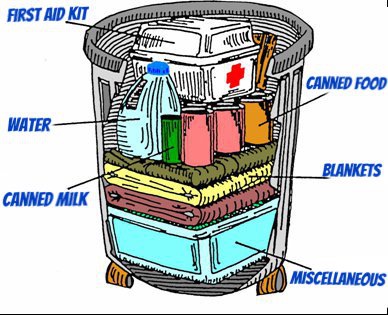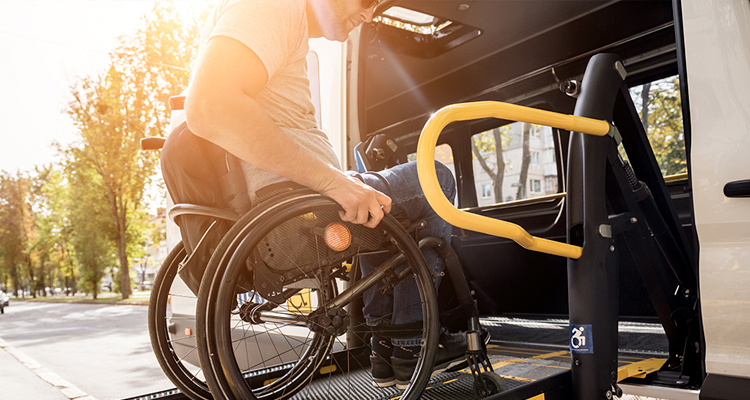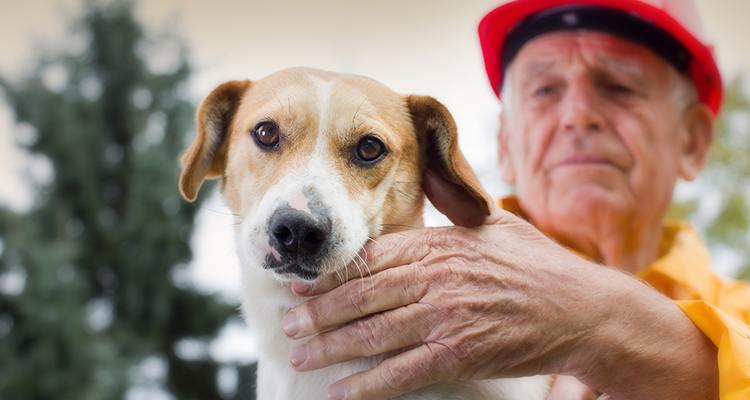It is unrealistic to think that someone else will provide for all of your family’s needs during and after a disaster. Eventually, help and resources will arrive but having an emergency kit is important. Your kit should be equipped to sustain your needs for a minimum of three days (seven days is preferred). This is especially important when you have special needs such as medications or assistive devices.
Preparing a kit doesn't have to cost a lot of money and you probably already have a lot of the things you will need. Putting them together so you can quickly find everything when disaster strikes will give you peace of mind and help you cope with the disaster much better than someone who is unprepared.
We've provided a few quick links to details about Making a Kit that suits your needs, including considerations for those with Access and Functional Needs, Children and Pets. Having a kit for your car and one at your place of work is also important because disaster can strike at any time.

One suggested method for storing emergency supplies is to place them in a large, covered trash container. They can be layered as shown and all kept together in a large covered container. Plastic containers come in all shapes and sizes. They’re water and rodent proof and are fairly durable. Choose the size that suits your needs. Be sure the container comes with a securing lid and preferably on wheels for easy transport.
*Note: It is best to store plastic water containers on top of the contents rather than on the bottom, where they could possibly crack and leak from the weight heavy objects placed on top of them.
Three-Day Survival Pack
Top of the Barrel
- Flashlight, radio, batteries
- First aid kit
- Drugs
- Prescription medicines
- Any medications your pets may need
- Dressings
- Adhesive tape 2” width roll
- Sterile bandage 4” width roll
- Sterile bandage 2” width roll
- Ace bandages
- Butterfly bandages
- Gauze pads (4” x4”)
- Triangular bandage
- Bandages, strips
- Cotton tipped swabs
- Miscellaneous
- Scissors
- Tweezers
- Thermometer
- First aid handbook
- Pocket knife
- Tissues
Middle of the Barrel
Food
- 3-day supply of food requiring no refrigeration
- Date all food items
- Examples:
- Canned tuna or pork and beans (1/2 lb. per person)
- Nonfat dry milk (1/2 lb. per person)
- Dried fruit (1/2 lb. per person)
- Canned orange or tomato juice
- Peanut butter (1/2 lb./person) *Can supply up to 2100 calories and essential nutrients
- Water (1-2 gallons per person per day)
Bottom of the Barrel
- BEDDING
- Sleeping bag/blankets
- Plastic sheet/tarp
- CLOTHING
- Change of clothes
- Gloves
- Sturdy shoes
- Jacket
- PERSONAL SUPPLIES
- Toiletries
- Eyeglasses
- Personal hygiene (toothbrush/paste, deodorant, feminine supplies, etc.)
- Towel
- Books, cards and/or games
- Paper/Pencil
- FUEL & LIGHT
- Flashlights
- Matches
- Candle
- Signal light
- Sterno canned heat
- MISCELLANEOUS
- Water purification tablets
- Liquid chlorine/household laundry bleach
- Eye dropper
- Kitty litter (to help with sanitation for human waste)
- EQUIPMENT
- Can opener
- Dishpan
- Dishes and utensils (disposable)
- Shovel
- Axe
- Bucket (plastic bag liners)
- SUGGESTED ADDITIONAL ITEMS
- Cash
- Cooking utensils
- Heavy-duty aluminum foil
- Bar soap
- Outdoor grill, camp stove, chafing dish, etc.
- Bucket
- Axe, hammer and assorted tools
- Household cleaner/detergent
- Filament tape
- INFANT NEEDS (if applicable)
- Infant supplies
- Toys for children
- PERSONAL DOCUMENTS
- Telephone numbers
- Birth certificate
- Health papers
- Passports
- U.S. service discharge papers
- Ownership certificates (for autos, trailers, boats, etc.)
- Social Security cards
- Insurance policies (health, life and auto)
- Will
- Certificates of authenticity (for objects of art, etc.)
- Household inventory
- Photographs of contents of every room (take photos from two angles of each room)
- Photographs of jewelry
Access and Functional Needs
Disaster preparedness is important for the whole community, especially those with access and functional needs and potentially vulnerable populations, such as older adults, children and those who are non-English speaking. A little advance planning will go a long way if you or your family member(s) require assistance and/or devices to maintain independence, communicate, obtain transportation services or require daily medical care.
Seniors and Older Adults
Older adults and their families can prepare for a disaster by identifying what the individual's needs are daily and how those needs may change or increase during a disaster.
Children
Children may be especially vulnerable during a disaster. For families with children, having a plan is a critical element in their disaster readiness.
Car
With so much time spent on the road, it’s a good idea to keep some basic emergency supplies in your vehicle.
Pet
In many homes, pets are a part of the family. When disaster strikes it will impact all members of a family – including pets. It’s important to plan ahead and ensure you’ve prepared for your pets just as you would for the other members of your family.






